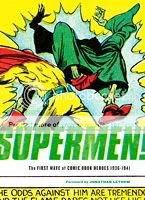Supermen! The First Wave of Comic Book Heroes 1936-1941
Greg Sadowski, editor
Jerry Siegel, Joe Shuster, George E. Brenner, Ken Fitch, Fred Guardineer, Bill Everett, Will Eisner, Lou Fine, Dick Briefer, Jack Kirby, Fletcher Hanks, Irv Novick, Jack Cole, Al Bryant, Ogden Whitney, Gardner Fox, Mart Bailey, Basil Wolverton, Joe Simon, writers/artists
192 pages
$24.99
Looked at strictly as an archival project, this Greg Sadowski-edited and designed anthology of early superhero comics is, like Paul Karasik’s Fletcher Hanks collection and DC’s Jack Kirby omnibuses before it, a real “here’s how it’s done” moment. Entertaining, left-field subject matter; eye-pleasing design; tactile paper stock; color technique and reproduction values that neither hide the material behind the haze of nostalgia nor try to mask its primitive origins with out-of-place high-gloss modernity; manageable length and heft; art presented at a powerful but not brobdingnagian size. The ongoing efforts of the aforementioned editors and publishers, along with the likes of Dan Nadel and Craig Yoe, truly have us living in the Golden Age of Reprints.
But how does the thing read? Well, generally speaking. I have to admit I don’t feel that the book is quite the revelation that, say, Jog argues it to be. Taken as a whole the early superhero comics reproduced here lack both the transcendent artistry and metaphorical/philosophical vision of Kirby’s Fourth World Omnibus and the eerie, obsessive-compulsive, barely checked madness of Hanks’s I Shall Destroy All the Civilized Planets! Meanwhile, though the wordy foreword by Jonathan Lethem makes much of how these protean efforts present an array of paths not taken by the more codified superhero stories that followed, those of us who’ve put a lot of time into reading modern superhero comics and nearly as much into arguing on their behalf are used to hunting down fruitfully unusual avenues of expression in that genre from past and present alike. Moreover, for all their occasional flashes of genuine sophistication or bracing weirdness, most of these stories are overwhelmed by their rudimentary plots, wooden dialogue, omnipresent narration, and the sense that for all their high-pitched violence, the actual emotional and physical stakes for the one-dimensional “characters” involved are vanishingly small. Read a couple at a time, the stories are entertainingly zesty; stretched one after the other, you’re gonna need to put the book down.
But even if the book isn’t the “reverse-neutron bomb” Lethem makes it out to be, who said it needed to be one? There’s enough pleasure to be had in recognizing the plug-ugly goons, heavy-lidded dames, and even the earliest traces of Kirbytech in the former Jacob Kurtzberg’s contributions; or seeing just how much sharper was Jack Cole than his contemporaries in terms of comedy and layout. I’ll take any excuse to look at comics by Fletcher Hanks, with his neurotically repeated figures and forms; placing them in close proximity with, say, Al Bryant’s “Fero the Planet Detective” sharpens our appreciation for the latter’s comically capricious violence and memorably hideous villains. Soon to be a star outside the genre, Basil Wolverton crafts a sci-fi adventure with character and costume designs that alternately prefigure the undergrounds and Chris Ware and a comparatively complex story that evokes the macho codes of honor and friendship often found in its pulp-prose forebears. Will Einser and Lou Fine turn in a tremendous, print-it-as-a-poster-and-hang-it-up cover for “Samson,” and give us one of the great simple pleasures in superhero comics–a bold, attractively streamlined costume–in the red-and-yellow person of the Flame.
As you might expect, any number of panels and word balloons are internet-meme-worthy–just flipping through at random I came across one of my favorite, a scene from a Bill Everett “Sub-Zero” comic in which the villain takes the time to fix up some foamy shaving cream, the better to fit the captured hero’s head for the electric chair’s skullcap. But there are moments of weird beauty, too: Eisner and Fine’s Flame standing like a Greek god as he speaks with a beautiful woman; Wolverton’s armored spacemen colliding in battle; Fred Guardineer bringing a statue of George Washington to uncanny life; Kirby’s proto-Roger Dean Martian landscape. And while the variety of approaches on display here may not necessarily blow minds, they should at least open some eyes. In a time when the major superhero companies seem dead-set on creating the most uniform tone possible across their lines–black-ops badasses in spandex at Marvel, a hyperviolent pantheon at DC–evidence that superheroes can behave in any number of ways against any number of threats is indeed liberating, perhaps even necessary. Forget the turgid prose–focus on the weird beauty. That’s what I did.
Tags: comics, comics reviews, Comics Time, reviews

